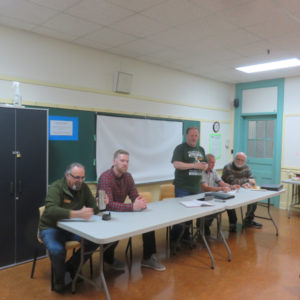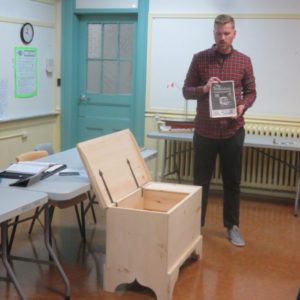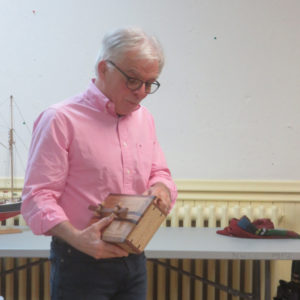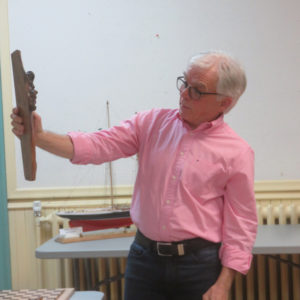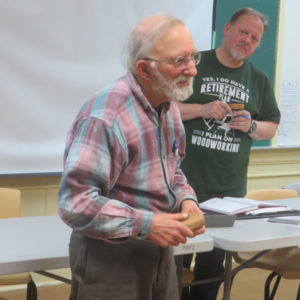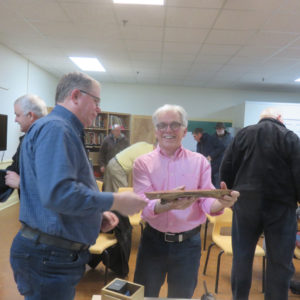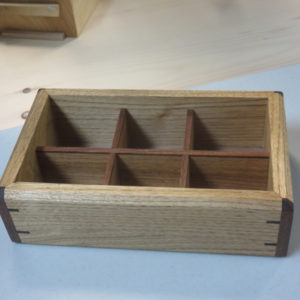AWA Meeting Minutes
Jan. 9, 2018 – North Woodside Community Center, 230 Pleasant, Dartmouth
18 members and 2 guests in attendance
Call to order by chair, Stephen Parsons, at 6:45
Welcome, intro of guests Brian Regan and Jim Smith
Business & Reminders
Review of agenda. Review of Minutes
- Business Arising
- Panel Presentation on making money from woodworking
- New Business
- Show and tell
- 50/50
MOTION: Accept agenda as presented
MOVED: Rick Pehrsson SECONDED: Gary Dumas MOTION CARRIED
MOTION: Accept minutes as presented
MOVED: Walt Vanderkeift SECONDED: John Green MOTION CARRIED
Business Arising
- Review of successful December meeting and grateful response from Salvation Army
- Notice of resignation from Board of AWA librarian, Tom Servaes. Mary Elizabeth / Stephen will continue to maintain online records. Julie offered to support library management by handling book borrowing and returns during the meetings. Stephen reminded us that members can take advantage of AWA library search and reservation options available through the website.
- Reminder that we are hoping to build three committees to support Board. A sign up sheet was circulated for people to indicate interest in any of the three committees:
o Finance & Compliance: Co-chairs – Stephen Parsons, Phil Carter
o Member Services: Chair – Walt VanderKeift
o Marketing & Communications: Chari – Mary Elizabeth O’Toole
Presentation
Our presentation this month was a panel discussion about making money from woodworking. The discussion was moderated by Stephen & Mary Elizabeth. Members were given a series of questions in advance to guide the discussion but there was also opportunity for questions and discussion from the members of the audience.
Panel members were:
- • Ted Monk (Ravinview, Spiffo @spiffoman) -Craft shows, online
- Brad Holley (HolleyWoodshop on Facebook, @Holleywoodshop) – online, commission work
- Steve LeBlanc (Expressions of Wood webpage, Facebook – manufacturing, custom
- Tom Patterson (fundraising experiences)
Our panelists starting by giving us an overview of how they used woodworking to make money – and what got them started on the path. As was to be experienced, their experiences varied widely. For example, Brad told us his initial motivation to start selling as a sideline was to finance new tools, something most of us can related to for sure. Tom mentioned that his experience was driven by his daughter’s need to raise funds for a group trip.
The presentation focused on a number of strategic areas with some discussion of what has been tried, what worked, what didn’t, and what might offer opportunities.
Product Strategy
How do you select product and decide how much of any product / or line to produce?
In the area of product strategy, all agreed that the decision about product selection was largely driven by what people will buy or what the customer wants. However, there is always influence of what you want to make. The trick, it seems, is finding the balance and still managing to find a sufficient market. That requires an understanding of the kind of customer, the type of product that they will buy – and finding the right mix.
Distribution Strategy
How do customers find the product to make purchases?
The consensus here was that you have to use different channels and selection depends on product, customer, pricing and timing. One of the issues arising is the cost of delivery, which led to some discussion about shipping options and flexibility. Distribution and location options include:
- Etsy – online store for handmade products
- Online through website
- Craft shows
- Delivery and installation
- Flea Markets
- Direct to customer (through referrals or invitation)
NOTE: If using mail for delivery, Ted and Brad both recommend Chit Chats Express for significant savings over Canada Post or other carriers
Marketing Strategy
How do you reach customers and get the word out about your products?
Ted emphasised that marketing has to be part of the business and Word-od-mouth is king for reaching people. Good reviews from others definitely helps to spread awareness for what you are doing./ Our panel and audience members use different strategies. What you use depends on customer, product, and your own interests and strengths. Strategies that were shared:
- Word of mouth
- Social media – Facebook and Instagram were most popular
- Shows – Craft shows, Ideal Home show, Hal-com…..
- Handout materials – business cards most important; flyers are generally not as effective
- Attention-grabbing displays
- Samples if appropriate
- Meet ups
Pricing Strategy
How do you determine pricing? Do you use a standard formula?
Pricing strategy was an area that reflected a real range of approaches. Tom’s experience in fundraising was based on how much needed to be made and how many items could be produced and setting a price that would be reasonable and allow them to sell lots. Steve, on the other hand, has to calculate large items operate a business so he works with a general formula that recognizes a set labour rate and markup on materials. It was generally agreed a large part of pricing is relies on guesswork, hopefully based on experience. Also, it is not always possible to have a price that covers all costs of materials and labour. Some of the considerations:
- Guesswork
- If you are fundraising, ask what you have to raise and how many products you can produce
- Use past experience to help you make realistic assessments
- It is important to be able to judge the appetite of customers for a range of products
- Identify work rate and material costs (+ markup)
- Consider how to remain competitive
- Notice what you have that is moving so you can make adjustments for future
- Ask what the market will bear
- Recognize that different products or product lines require different strategies
- Don’t be afraid to ask for what the product is worth
- Understand that some items you will make (especially for experience, learning, artistic expression….) will not recover the cost and time to make
Lessons Learned
Finally, we asked panel members to share some of the key lessons that they had learned. Here are thoughts that they shared with us:
- Know your reason for getting involved
- Ask what you want of the activity
- Consider “what if you are successful?”
- Remember that just because you’re a maker doesn’t make you a business person
- Learn when to say no
- Do what you want to do
- Making big bucks is fiction
- Don’t put all your eggs in one basket – diversify
- Employees add a layer of complexity
- Custom work can be challenging – you have to be flexible with customer requirements
Thanks for all the members who stepped up to volunteer for the panel and to those that contributed from the audience. It was an informative presentation that led to lively discussion.
Show and Share
This month, our challenge was to complete a UFO from the pile – something already in progress.
• John shared his schooner – same style as bluenose but not direct bluenose replica
• Bill finished a spokeshave with some modifications
• Gary showed us a box that he had started as a possible urn as well as a piece he made from a burl that he had around for a project
• Dave made a decorative holder for a piece of elm that he had recovered from a fallen tree in his yard
• Brad brought a tool chest and a chess board that he had on his work bench
50/50
Congratulations to this month’s winner, Tom Patterson, who went home with a win of $26.50
Ship Builders Guild Meeting
On behalf of the Maritime Ship Modellers’ Guild, John Green extended and invitation for members to attend their meetings.
The Feb. meeting will be on Wednesday Feb. 7 at 7:30 on the 2nd floor of the Maritime Museum
Starting in March, meetings will be moving to the 3rd Saturday of the month from 10-noon.
Next Meeting / Challenge
Tuesday, February 13, 2018
CHALLENGE: Recycle / upcycle – incorporate wood from another product or reclaimed stash.
This content is restricted to AWA members. If you are an existing user, please login. New users may register below.


